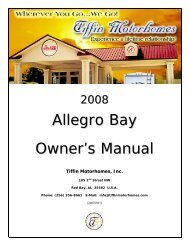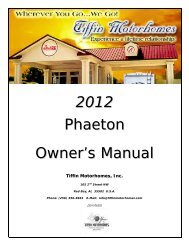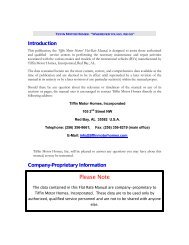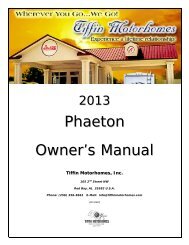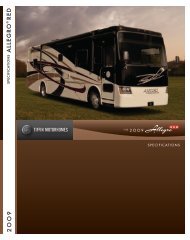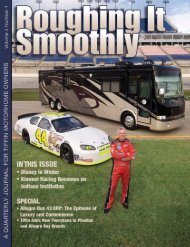Allegro RED Owner's Manual - Tiffin Motorhomes
Allegro RED Owner's Manual - Tiffin Motorhomes
Allegro RED Owner's Manual - Tiffin Motorhomes
- No tags were found...
You also want an ePaper? Increase the reach of your titles
YUMPU automatically turns print PDFs into web optimized ePapers that Google loves.
TIFFIN MOTORHOMES –ALLEGRO <strong>RED</strong>® Chapter 13 ROUTINE MAINTENANCEUnderstanding Tire Pressure and Load LimitsTire inflation pressure is the level of air in the tire that provides it with load-carrying capacity and affects the overallperformance of the vehicle. The tire inflation pressure is a number that indicates the amount of air pressure—measuredin pounds per square inch (psi)—a tire requires to be properly inflated. (You will also find this number on the vehicleinformation placard expressed in kilopascals (kPa), which is the metric measure used internationally).Vehicle manufacturers determine this number based on the vehicle’s design load limit, that is, the greatest amount ofweight a vehicle can safely carry and the vehicle’s tire size. The proper tire pressure for your vehicle is referred to as the“recommended cold inflation pressure.” (As you will read below, it is difficult to obtain the recommended tire pressureif your tires are not cold.)Because tires are designed to be used on more than one type of vehicle, tire manufacturers list the “maximumpermissible inflation pressure” on the tire sidewall. This number is the greatest amount of air pressure that should everbe put in the tire under normal driving conditions.Checking Tire PressureIt is important to check your vehicle’s tire pressure at least once a month for the following reasons:• Most tires may naturally lose air over time• Tires can lose air suddenly if you drive over a pothole or other object or if you strike the curb when parking• With radial tires, it is usually not possible to determine under-inflation by visual inspectionFor convenience, purchase a tire pressure gauge to keep in your vehicle. Gauges can be purchased at tire dealerships,auto supply stores, and other retail outlets.The recommended tire inflation pressure that vehicle manufacturers provide reflects the proper psi when a tire is cold.The term cold does not relate to the outside temperature. Rather, a cold tire is one that has not been driven on for atleast three hours. When you drive, your tires get warmer, causing the air pressure within them to increase. Therefore, toget an accurate tire pressure reading, you must measure tire pressure when the tires are cold or compensate for theextra pressure in warm tires.Steps for Maintaining Proper Tire Pressure• Step 1: Locate the recommended tire pressure on the vehicle’s tire information placard, certification label,or in the owner’s manual• Step 2: Record the tire pressure of all tires• Step 3: If the tire pressure is too high in any of the tires, slowly release air by gently pressing on the tire valvestem with the edge of your tire gauge until you get to the correct pressure• Step 4: If the tire pressure is too low, note the difference between the measured tire pressure and correct tirepressure. These “missing” pounds of pressure are what you will need to add13-12




